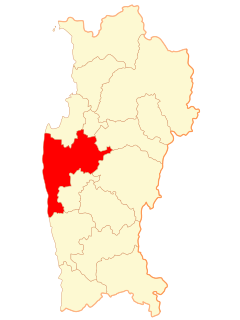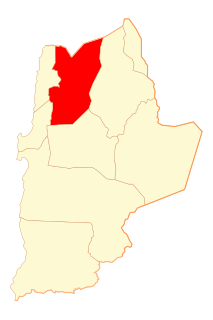Related Research Articles
The Argentine Interconnection System is a wide area synchronous grid that links the regional networks of all Argentinian provinces, with the exception of Tierra del Fuego. It is also connected to the power grids of several neighboring countries.

The electricity sector in Bolivia is dominated by the state-owned ENDE Corporation, although the private Bolivian Power Company is also a major producer of electricity. ENDE had been unbundled into generation, transmission and distribution and privatized in the 1990s, but most of the sector was re-nationalized in 2010 (generation) and 2012.
The electricity sector in Argentina constitutes the third largest power market in Latin America. It relies mostly on thermal generation and hydropower generation (36%). The prevailing natural gas-fired thermal generation is at risk due to the uncertainty about future gas supply.
As of August 2020 Chile had diverse sources of electric power: for the National Electric System, providing over 99% of the county's electric power, hydropower represented around 26.7% of its installed capacity, biomass 1.8%, wind power 8.8%, solar 12.1%, geothermal 0.2%, natural gas 18.9%, coal 20.3%, and petroleum-based capacity 11.3%. Prior to that time, faced with natural gas shortages, Chile began in 2007 to build its first liquefied natural gas terminal and re-gasification plant at Quintero near the capital city of Santiago to secure supply for its existing and upcoming gas-fired thermal plants. In addition, it had engaged in the construction of several new hydropower and coal-fired thermal plants. But by July 2020 91% of the new capacity under construction was of renewable power, 46.8% of the total solar and 25.6% wind, with most of the remainder hydro.
As required by the Constitution, the electricity sector is federally owned, with the Federal Electricity Commission essentially controlling the whole sector; private participation and foreign companies are allowed to operate in the country only through specific service contracts. Attempts to reform the sector have traditionally faced strong political and social resistance in Mexico, where subsidies for residential consumers absorb substantial fiscal resources.

Chile's total primary energy supply (TPES) was 36.10 Mtoe in 2014. Energy in Chile is dominated by fossil fuels, with coal, oil and gas accounting for 73.4% of the total primary energy. Biofuels and waste account for another 20.5% of primary energy supply, with the rest sourced from hydro and other renewables.
Paraguay is one of the few countries in Latin America that has maintained an integrated public monopoly on electricity. Hydropower comprises nearly 100 percent of electricity in Paraguay; 90 percent of generated energy is exported, with neighboring Argentina and Brazil receiving the majority. Paraguay is one of the world's largest electricity net exporters.

A wide area synchronous grid is a three-phase electric power grid that has regional scale or greater that operates at a synchronized utility frequency and is electrically tied together during normal system conditions. Also known as synchronous zones, the most powerful is the synchronous grid of Continental Europe (ENTSO-E) with 859 gigawatts (GW) of generation, while the widest region served is that of the IPS/UPS system serving most countries of the former Soviet Union. Synchronous grids with ample capacity facilitate electricity trading across wide areas. In the ENTSO-E in 2008, over 350,000 megawatt hours were sold per day on the European Energy Exchange (EEX).
The Sistema Interconectado del Norte Grande or SING is an alternating current power grid serving the Norte Grande zone of Chile, it produces 19% of the national power generation. The SING covers the three northernmost regions of Chile including Arica y Parinacota, Tarapacá and Antofagasta Region.
The Sistema Eléctrico de Magallanes or SEM is an alternating current power grid serving the Magallanes and Antartica Chilena Region of Chile. All of the SEM's power generation is produced by combustion of fossil fuels in thermal power plants, some of the fuel comes from the oilfields in the Strait of Magellan. SEM's power generation stands currently for about 0.8% of the national generation. The communes of Antártica and Cabo de Hornos, including Puerto Williams are not connected to the system.
The Sistema Eléctrico de Aysén (SEA) is an alternating current power grid serving the Aysén del General Carlos Ibáñez del Campo Region of Chile. It is operated by a private company called EDELAYSEN, whose motto is La Luz del Sur.
The electricity sector in Venezuela is one of the few in the world to rely primarily on hydroelectricity, which accounted for 64% in 2015.
In 2018 Chile produced about 7% of its electricity from solar power. As of year end, it had 2137 MW of solar PV capacity. In July 2020 installed solar capacity had risen to 3104 MW, with another 2801 MW under construction.

Talinay Wind Farm, also known by its official name of Parque Eolico Talinay, is a wind farm in northern Chile, located in the region of Coquimbo near the city of Ovalle. It has an installed capacity of 90 MW and is capable of generating about 200 GWh annually, which is set to be expanded to 500 MW in the future, with a second wind park Parque Eolico Talinay II adding a further 500 MW.

The Taltal wind farm is a wind energy project in northern Chile. The farm is named after the commune of Taltal, where the project is located, in the region of Antofagasta, 1,550 km (960 mi) north of Santiago. The plant's connection to the Chilean electricity grid was reported on 5 December 2014. The name "Taltal" came from the indigenous word Thalthal, which means "night bird".

María Elena Solar Power Plant is a concentrated solar power plant with a molten-salt technology system that is currently under construction in the commune of María Elena in the Antofagasta Region of Chilé.
Renewable energy in Chile is classified as Conventional and Non Conventional Renewable Energy (NCRE), and includes biomass, hydro-power, geothermal, wind and solar among other energy sources. Most of the time, when referring to Renewable Energy in Chile, it will be the Non Conventional kind.

Chapiquiña power plant is a hydroelectric power plant in northern Chile. It takes water from the Canal Lauca and produces electrical power through a Pelton turbine.
Venezuela has experienced a marked deficit in the generation of electrical energy. The immediate cause of the energy crisis was a prolonged drought that caused the water in the reservoir of the Simón Bolívar Hydroelectric Plant to reach very low levels. Although various measures were taken to overcome the crisis, one of the most controversial was the implementation of a program of electrical rationing throughout the country, except in the capital Caracas, which was ultimately officially suspended in June 2010, due to the recovery of reservoirs due to the rains, and not to interrupt the transmission of the 2010 FIFA World Cup. Power cuts have continued to occur in the interior of the country, although with less frequency and duration, this time driven by failures in other parts of the system. The situation of "electrical emergency" decreed by the government on 21 December 2009 was suspended on 30 November 2010; however, on 14 May 2011, after the country experienced two national blackouts, the government of Hugo Chávez announced a temporary rationing plan and acknowledged that the electricity system continued to face "generation weaknesses" that they did not expect to surpass until end the year.

On 16 June 2019, a large-scale power outage struck most of Argentina, all of Uruguay, and parts of Paraguay, leaving an estimated total of 48 million people without electrical supply.
References
- ↑ SIC installed capacity. Central Energía. Retrieved: 15-05-2012
- ↑ . Coordinador Electrico Nacional. Retrieved 04-28-2022